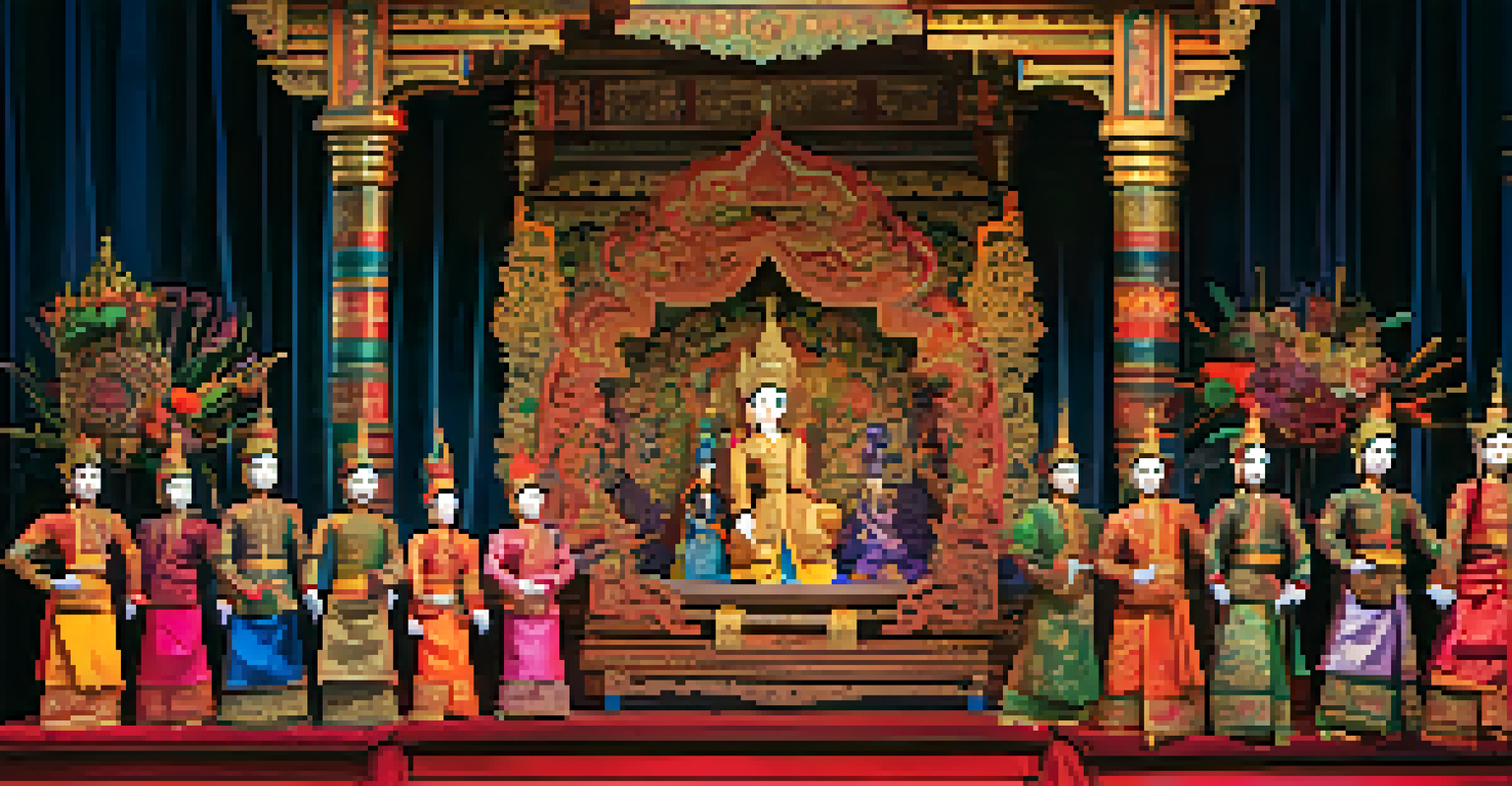The Origins of Thai Folk Tales: A Journey Through Time

The Historical Context of Thai Folk Tales
Thai folk tales have a rich history that intertwines with the cultural and social dynamics of Thailand. Originating from various regions, these stories reflect the beliefs, traditions, and values of the Thai people. They often serve as a mirror to the historical events that shaped the nation, providing insights into the lives of those who came before us.
Stories can conquer all problems.
These tales were passed down orally for generations, evolving with each storyteller's unique touch. The significance of oral tradition in preserving these narratives cannot be overstated, as it allowed for the adaptation of stories to reflect contemporary issues. This adaptability ensured that folk tales remained relevant and resonant with audiences across different eras.
Moreover, the use of local dialects and cultural references in these tales highlights the diversity within Thailand. Each region boasts its own variations, showcasing distinct characters and lessons that are culturally significant. This regional richness not only preserves local identities but also unites them under the umbrella of Thai heritage.
Key Themes in Thai Folk Tales
Thai folk tales are rich with themes that resonate deeply with both the past and present. Common motifs include morality, justice, and the triumph of good over evil, often encapsulated in captivating narratives. These themes serve as moral lessons, guiding listeners toward ethical behavior and community values.

Nature frequently plays a central role in these stories, reflecting the Thai people's deep connection to the environment. Tales often feature animals as characters, symbolizing various human traits and providing relatable lessons. For instance, clever animals might outsmart their foes, teaching the value of wit and intelligence over brute strength.
Cultural Significance of Folk Tales
Thai folk tales reflect the nation's beliefs and values, serving as a vital link between generations.
Additionally, the theme of spirituality is prominent, as many folk tales incorporate elements of Buddhism and animism. This blend of beliefs offers a unique perspective on life and death, illustrating how these stories serve as a way to navigate the complexities of existence. Through these narratives, listeners gain insight into the spiritual landscape that shapes Thai culture.
The Role of Folklore in Thai Society
Folklore plays a crucial role in shaping Thai society, serving as a link between generations. These tales are often shared during family gatherings and community events, reinforcing social bonds and cultural identity. As stories are passed along, they help instill a sense of belonging and pride in one’s heritage.
Folklore is the living tradition of a culture; it is the stories that keep the culture alive.
Moreover, folk tales often reflect societal norms and expectations, acting as both entertainment and a form of education. They address complex social issues such as gender roles, family dynamics, and morality through engaging narratives. By embedding these lessons within entertaining stories, they become more impactful and easier to remember.
In contemporary Thailand, folk tales continue to influence art, literature, and performance. From traditional puppet shows to modern adaptations in film and literature, these narratives remain vibrant and relevant. This ongoing evolution highlights the resilience of Thai culture as it adapts to changing times while staying rooted in its rich storytelling tradition.
Famous Thai Folk Tales and Their Characters
Among the plethora of Thai folk tales, a few stand out due to their iconic characters and enduring popularity. One such tale is the story of 'Phra Aphai Mani,' which follows a prince with the ability to play magical music that captivates all who hear it. This tale not only entertains but also explores themes of love, adventure, and the consequences of desire.
Another well-known character is 'Khan Kluay,' an elephant who embarks on a journey filled with courage and friendship. This story emphasizes the importance of bravery and loyalty, resonating with audiences of all ages. Through these memorable characters, Thai folk tales leave a lasting impression on listeners, teaching valuable life lessons.
Themes of Morality and Spirituality
Common themes such as morality and spirituality are woven throughout Thai folk tales, offering moral guidance and insight into human nature.
These tales are often retold in various forms, from books to animated series, ensuring their continued relevance in modern society. As they evolve, new interpretations bring fresh perspectives while maintaining the core values embedded in the original stories. This adaptability is key to their survival and popularity in the ever-changing landscape of Thai culture.
The Influence of Buddhism on Thai Folk Tales
Buddhism has significantly influenced Thai folk tales, shaping their themes and narratives. Many stories integrate Buddhist principles, such as karma and the importance of compassion, encouraging listeners to reflect on their actions. This spiritual aspect not only enriches the tales but also aligns with the moral framework that guides Thai society.
Characters in these folk tales often undergo transformations that mirror the Buddhist journey toward enlightenment. Through trials and tribulations, they learn valuable lessons about humility, kindness, and the interconnectedness of all beings. This narrative arc helps instill a sense of personal responsibility and encourages positive behavior among listeners.
Additionally, local beliefs and practices often intertwine with Buddhist teachings, creating a unique tapestry of spirituality within Thai folk tales. These stories serve as a bridge between the sacred and the everyday, reminding people of the divine presence in their lives. As such, they play a vital role in maintaining cultural continuity while fostering a deeper understanding of shared values.
The Evolution of Thai Folk Tales in Modern Media
In recent years, Thai folk tales have found new life through various forms of modern media. Television shows, movies, and even video games are increasingly adapting these traditional stories, making them accessible to younger audiences. This transition not only preserves the tales but also reinvents them for contemporary entertainment.
One notable example is the animated film adaptations that introduce iconic characters and narratives to a global audience. These modern interpretations often incorporate advanced animation techniques and storytelling methods, ensuring that the essence of the original tales remains intact. Such adaptations can spark interest in the cultural heritage of Thailand, inspiring viewers to explore the stories further.
Modern Adaptations in Media
Contemporary adaptations of Thai folk tales in film and digital media help preserve these stories while making them accessible to new audiences.
Social media platforms also play a significant role in this evolution. With the rise of digital storytelling, folk tales can be shared and celebrated in new ways, reaching a diverse audience worldwide. This accessibility fosters a renewed appreciation for the rich tapestry of Thai culture and encourages a dialogue about its significance in today's world.
Preserving Thai Folk Tales for Future Generations
As the world becomes increasingly globalized, preserving Thai folk tales has become more important than ever. Efforts are underway to document and archive these stories, ensuring that they are not lost to time. This preservation work often involves collaborating with local communities to capture the unique nuances of each tale.
Educational initiatives are also being developed to teach younger generations about their cultural heritage. Schools and community centers are incorporating folk tales into their curricula, emphasizing the importance of storytelling as a means of understanding one’s identity. By fostering a love for these narratives, future generations can carry on the tradition.

Additionally, festivals and cultural events celebrating folk tales play a crucial role in keeping these stories alive. Through performances, exhibitions, and storytelling sessions, communities can come together to honor their heritage. This communal celebration not only reinforces cultural pride but also ensures that the magic of Thai folk tales continues to enchant audiences for years to come.